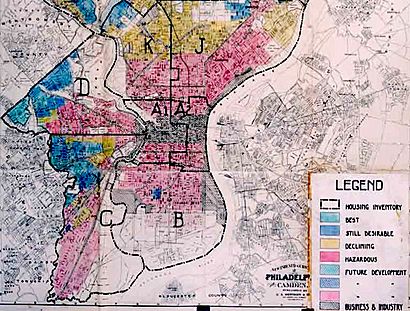Redlining facts for kids

Redlining is when people or companies refuse to provide services to people in certain neighborhoods. This often happens because of the race or background of the people living there. It can also happen by making prices much higher for them. Redlining is like a modern form of segregation, which means keeping groups of people separate.
While redlining is most known for stopping people from getting banking services or insurance, it can also affect other things. This includes health care or even access to supermarkets. People in redlined areas might find it hard to get basic services that others take for granted.
Contents
What is Redlining?
Redlining is a unfair practice where services are denied to people based on where they live. The name "redlining" comes from the old practice of drawing red lines on maps. These lines marked areas where companies would not invest or provide services. These areas were often home to minority groups.
This practice made it very hard for people in these neighborhoods to improve their lives. It stopped them from buying homes, starting businesses, or getting good health care.
How Did Redlining Start?
Redlining became common in the United States in the 1930s. This was during the Great Depression. The government created the Home Owners' Loan Corporation (HOLC). The HOLC was meant to help people keep their homes.
However, the HOLC created maps that rated neighborhoods based on how "risky" they were for loans.
- Green areas were seen as the best and safest.
- Blue areas were still good.
- Yellow areas were considered declining.
- Red areas were seen as the riskiest. These were often older neighborhoods with many minority residents.
Banks then used these maps to decide where to give out loans. They would often refuse to give loans to people in the "red" areas. This meant people in these areas could not buy homes or fix up their houses.
What Services Were Denied?
Redlining affected many parts of life.
- Home Loans: Banks would not lend money to people in redlined areas to buy or repair homes. This made it hard for families to build wealth.
- Insurance: Companies would refuse to sell home insurance or car insurance. If they did, it was at very high prices.
- Businesses: It was hard for small businesses to get loans to start or grow in these areas. This meant fewer jobs and services for the community.
- Supermarkets and Healthcare: Sometimes, even basic services like grocery stores or doctors' offices would not open in redlined neighborhoods. This created "food deserts" or areas without easy access to medical care.
Why Was Redlining a Problem?
Redlining caused many problems for communities and families.
- Less Wealth: People in redlined areas could not buy homes, which is a main way families build wealth over time.
- Poor Conditions: Without investment, homes and buildings fell apart. Neighborhoods became rundown.
- Limited Opportunities: It was harder to get good jobs or education. This trapped families in poverty.
- Racial Inequality: Redlining made racial inequality worse. It kept people of color from moving into better neighborhoods or getting the same chances as white people.
Is Redlining Still Happening?
Direct redlining, like drawing red lines on maps, is now illegal. Laws like the Fair Housing Act of 1968 made it against the law to discriminate in housing.
However, some people argue that the effects of redlining can still be seen today. Some neighborhoods that were redlined decades ago still struggle with less investment and fewer services. This is called "legacy redlining." New forms of unfair practices can also happen, like charging higher interest rates to certain groups.
See also
 In Spanish: Redlining para niños
In Spanish: Redlining para niños

